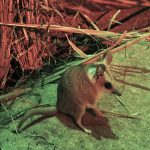FAT-TAILED DUNNART
A Master of Survival
A Tale of Adaptation in the Australian Outback
The Fat-tailed Dunnart is a marvel of Australian wildlife—small in stature, yet mighty in its resilience. Measuring just 60 to 90 millimetres from nose to base, with a tail stretching another 45 to 70 millimetres, this diminutive marsupial roams some of the harshest environments in central and southern Australia. With fur that is soft grey-brown above and pale below, it blends effortlessly into the dry grasses and dusty earth.
Unique Features
- Sausage-like Tail: The most striking feature of the Fat-tailed Dunnart is its plump tail, which swells with stored fat much like a miniature sausage. This clever adaptation acts as an energy reserve, sustaining the animal during periods when food is scarce.
- Torpor Specialist: By entering a state called torpor
the Dunnart dramatically reduces its body temperature and slows its metabolism. Imagine wrapping yourself in a snug blanket on a cold day, but for the Dunnart, this means real survival during chilly nights or droughts.
Life in the Shadows
- Nocturnal Lifestyle: Emerging after sunset, the Dunnart follows the gentle rustle of insects under moonlight. Its refined hearing and sharp sense of smell guide it to meals hidden amongst pebbles and grasses.
- Secret Nooks: By day, it hides from predators and the searing sun in burrows, under fallen logs, or wedged between stones.
A Diet of Delicacies
Fat-tailed Dunnarts are primarily insectivorous. They chase beetles, spiders, and other small invertebrates with nimble precision. Occasionally, they may supplement their diet with tiny vertebrates or even seeds and fruits if circumstances demand.
Breeding Marvels
- The breeding season extends from July to February, synchronised with times of relative abundance.
- Females give birth to litters of up to ten tiny, underdeveloped joeys—each no larger than a grain of rice.
- The young reside in their mother’s pouch for four weeks, then cling to her back before fully venturing into the world at around ten weeks.
Interesting Facts
| Feature | Details |
|---|---|
| Fat Storage | The tail can contain up to a third of the animal’s total body weight in fat. |
| Torpor | Dunnarts can drop body temperature close to their environment for hours or days. |
| Communication | Although usually quiet, they produce soft, rapid squeaks during social encounters. |
| Lifespan | Short but eventful—typically 1 to 2 years in the wild. |
| Sensory Strengths | Excellent night vision, acute sense of smell and even vibrissae (whiskers) for touch. |
| Eco-Engineers | By preying on insects, Dunnarts help control invertebrate populations. |
Threats and Conservation
Though listed as Least Concern by the IUCN Red List, the Fat-tailed Dunnart faces ongoing threats:
- Habitat Loss: Land clearing for agriculture and development fragments its home range.
- Introduced Predators: Cats and foxes pose serious dangers to populations in the wild.
- Climate Change: Increasing aridity threatens the delicate balance of food and shelter.
Sensory Experience
Step into the world of the Fat-tailed Dunnart: Feel the cool earth as you nestle beneath a sun-baked log. Inhale the dry aroma of spinifex and acacia. Listen, in the quiet of night, for the faintest whisper of movement—a tiny hunter stirring to life as the world sleeps.
Why Preserve Their World?
The endurance and ingenuity of the Fat-tailed Dunnart inspires admiration. Every adaptation, from its torpor to its fat-storing tail, tells a story of survival. By conserving their fragile habitats, we ensure these incredible tales of resilience and adaptation continue for generations to come.
Learning about the Fat-tailed Dunnart is not just an exploration of a unique species—it is an invitation to respect and safeguard Australia’s astonishing biodiversity.

